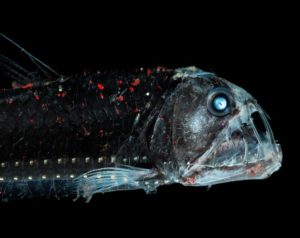
The ocean is undoubtedly the most mysterious habitat on Earth. In fact, the National Oceanic and Atmospheric Administration (NOAA) reports that a whopping 95 percent of the ocean remains unexplored. This especially goes for the ocean below the surface, and more specifically, the things that lurk there. As for some of the things we have discovered swimming around down there, arguably none are more intimidating in appearance than the deadly Viperfish.
First described by german scientists Marcus Elieser Bloch and Johann Gottlob Schneider in 1801, the viperfish is ghastly in appearance.
But before you go cancelling your beach trip, it must be emphasized that humans rarely ever come in contact with this fish. That’s because it lives almost two miles below the ocean surface. No light reaches this far, and so the viperfish must utilize stealth and trickery to hunt its prey. Using an extended spine on its dorsal fin, the viperfish acts as a fisherman of sorts, flashing a light at the tip of the spine to lure in unsuspecting fish. With their dark coloration, viperfish can appear almost invisible. They have been observed floating motionless in the water for hours, waiting for the right moment to strike.
Now, imagine you’re a fish in the cold ocean depths. It’s dark, and a meal is hard to come by. Up ahead, you see a light. It flashes, beckons to you. Everything glows down here. It must be food. You swim closer.
Wham! The viperfish’s long fangs pierce you like harpoons, and you’re swallowed whole.
The stomach contents of captured viperfish reveal lanternfish, bristlemouths, and other fish, suggesting that the viperfish is not very particular about its food source. One cannot afford to be picky in the cold, dark depths, where food is scarce.
At night, the viperfish migrates toward the shallower waters of the ocean’s Twilight Zone, where food is more plentiful. But don’t worry; the Twilight Zone ranges from about 650 feet to around 3,300 feet.
To put your mind even more at ease, the Pacific viperfish maxes out at about 23 inches in length, and its cousins are even smaller (the dana viperfish, a resident of the Caribbean, measures about 6 inches).
So, if the viperfish is terrorizing the smaller denizens of the deep, what’s eating them? Well, dolphins and certain types of sharks are known to prey on them. That’s right, Flipper makes a snack out of viperfish! The viperfish’s main predator, however, is the dragonfish, which is arguably just as terrifying as the viperfish with its xenomorph-like appearance.
The ocean is a place that is filled with beauty, danger, and mystery. We’ve discovered the viperfish after having explored only 5 percent of the sea. Who’s to say what we’ll discover in the remaining 95?
Appreciate you sharing, great article post. Really looking forward to read more. Fantastic. Georgina Hermy Harmonia